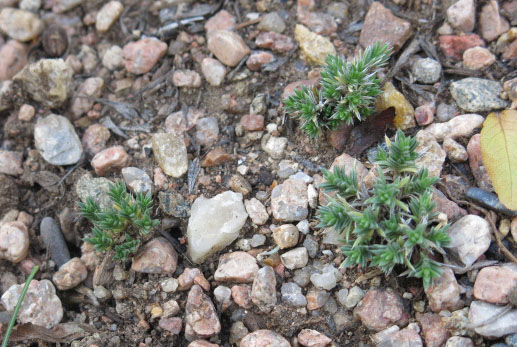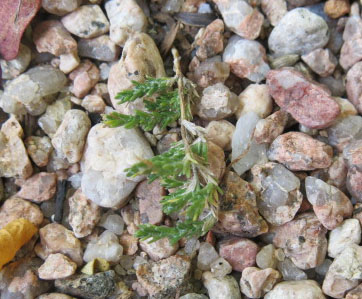Pictures of some very tiny phloxes, grown from Alplains seed. The first two were planted last year; the third, this year.
I stupidly planted all three seedlings of Phlox griseola directly from the seed pot into the garden, thinking that at least two, if not three, would die, and now I can't transplant them.
Bob



Comments
Lori S. (not verified)
Little cuties... What species
Sat, 10/18/2014 - 3:57pmLittle cuties... What species are the first and third photos?
P. griseola looks terrific, from the photo on the back cover of the 2012 Alplains catalogue (yes, this just happened to be laying on the table... ). The description of P. opalensis sounds great too: "compact buns of square stems are covered with white wool and bear large white flowers". I was already hooked at the "white wool" part.
Robert Nold
I thought the names would
Sat, 10/18/2014 - 4:14pmI thought the names would display, when you move the cursor over the pictures, but, anyway, first is P. austromontana subsp. jonesii, and third is P. opalensis.
Had a large patch of P. hoodii here, ages ago, but it died out for some reason. Rabbits like the microphloxes. They seem to think it's funny to tear them apart. (It isn't.) A couple of years ago I decided to replace the microphloxes, and this is the result.
Once the phloxes in the ground, and have gone through a winter, transplanting usually kills them. Ask me how I know....
Bob
Lori S. (not verified)
Nold wrote:
Sat, 10/18/2014 - 4:50pm[quote=Nold]
I thought the names would display, when you move the cursor over the pictures, but, anyway, first is P. austromontana subsp. jonesii, and third is P. opalensis.
[/quote]
Yes, one would think. It doesn't work for me, in any case.
Oh, so there is P. opalensis in the flesh, so to speak! Cool! Hope to see it as it matures.
Ah, I guess those roots drive down deep and fast...
Robert Nold
Taproots, mostly. Phlox
Sat, 10/18/2014 - 5:10pmTaproots, mostly. Phlox longifolia moves around (a lot), and that can be dug up and transplanted.
The little Phlox opalensis is growing in my new sand pile. The sand pile was originally intended to be nothing but sand and gravel, but the sand reeked of diesel fuel, and I wasn't able to find any information on diesel-fuel tolerant plants, so, against all my principles, I added a couple of bags of organic matter and some Yum Yum Mix, in hopes that if the sand was drenched in diesel fuel, the microbes in the Yum Yum would take care of that, and the smell was gone by this spring. Fortunately most of the organic gunk is gone, too.
(I'm too superstitious to say what else is growing in the sand pile. Oh, Phlox woodhousii. Among other things.)
Bob
Lori S. (not verified)
What, the perfect environment
Sat, 10/18/2014 - 6:19pmWhat, the perfect environment to grow oil shale plants (e.g. Penstemon debilis), squandered? ;-)
Don't worry about bringing down the wrath of the gods... no one visits this site, so your secret should be safe.
Robert Nold
Oh, I don't know. Every time
Sat, 10/18/2014 - 6:27pmOh, I don't know. Every time I say I've finally gotten ********* *********** to grow, it doesn't appear the next year.
Penstemon debilis doesn't need oil shale (really just shale with paraffin in it), but it detests organic matter like peat moss. (I blame everything on organic matter in the soil.)
Attached, poor photo of sand pile, looking across from the other raised bed, which is just dirt and gravel. Lots of cages to protect young plants from rabbits. Mostly cactus and oncocyclus iris, with some other things, including Phloxes opalensis and woodhousii, and Abronia nana.
Bob
Lori S. (not verified)
Wow! Would love to be able
Sat, 10/18/2014 - 6:44pmWow! Would love to be able to pore over it, especially when those irises were in bloom!
Robert Nold
The sand pile was originally
Sat, 10/18/2014 - 7:15pmThe sand pile was originally for Abronia nana and some other plants, but I moved a bunch of oncos there, since I thought having two raised beds with oncos would enhance the snob appeal, and they've mostly flourished. Iris paradoxa has been practically evergreen here, and seemed to relish the worst summer I've ever seen here (constant thunderstorms and no sun). (They'll probably all die now that I mentioned them.
Bob
Maryanne Gryboski
Nice photo of your sand pile;
Tue, 10/28/2014 - 5:31amNice photo of your sand pile; thanks for the inspiration.
Maryanne
Robert Nold
Thanks. Construction required
Tue, 10/28/2014 - 9:32amThanks. Construction required a great deal of thought. I ordered pea gravel, and piled it there, and then I ordered sand, and piled it on top. Sort of mixed the two together.
I added a few rocks so people wouldn't freak out. This is an adjunct to the large "main sand pile", as they might call it across the Atlantic, or "great sand pile".
Bob
Robert Nold
More pictures of the sand
Tue, 10/28/2014 - 6:02pmMore pictures of the sand piles. (Grade Z pictures, sorry.)
First is the large sand pile. Second is the little sand pile. Cages are for irises, etc. (Iris paradoxa in cage in lower left of first picture.)
The sand piles were created so I wouldn't have to do any watering.
Bob
deesen (not verified)
Been doing some browsing
Wed, 10/29/2014 - 3:06amBeen doing some browsing through the Alplains catalogue, making lists and things. Better stop before the kid's inheritance hits nil!
Lori S. (not verified)
deesen wrote:
Tue, 11/11/2014 - 4:56pm[quote=deesen]
Been doing some browsing through the Alplains catalogue, making lists and things. Better stop before the kid's inheritance hits nil!
[/quote]
You know, in the long run, the kid will probably appreciate more what he/she earns for him/herself...
(Just trying to help you out there, David! )
)
Maryanne Gryboski
Bob, what's a rough estimate
Tue, 11/11/2014 - 4:09pmBob, what's a rough estimate on the depth of your sand pile?
Robert Nold
Anywhere from one to three
Tue, 11/11/2014 - 5:39pmAnywhere from one to three feet deep. (30-90cm.) Half sand and half pea gravel. There are several beds like this.
If container-grown plants are planted, they need extra watering to get their roots down into the sand.
Just about the coldest place in North America right now. Low of 0 (-17C) for tonight.
Lori S. (not verified)
Winter hit suddenly and with
Tue, 11/11/2014 - 6:58pmWinter hit suddenly and with great finality on Sunday here. There's probably nothing more pathetic than feeling compelled to one-up your already dismal weather forecast but...I hate to say that it's already -15 C here, with an overnight low of -22 C forecast. Phooey. My hands are cold just sitting here at the computer.
Robert Nold
Oh, I looked at the weather
Tue, 11/11/2014 - 7:19pmOh, I looked at the weather channel for Calgary and they have things mixed up. I guess it's nice to know that all this air isn't aimed directly at me.
I suppose it will be 30C here next week. It's nice to know that alpine plants manufacture their cryoprotective sugars year-round.
Bob
Robert Nold
More phloxes.
Wed, 11/12/2014 - 8:57pmMore phloxes.
Phlox hoodii, P. muscoides (aka P. hoodii subsp. muscoides, or whatever), P. alyssifolia. Low-res pictures.
It's the middle of November, and it will be ten below zero tonight.
Robert Nold
More tiny phloxes. These are
Thu, 11/13/2014 - 6:09pmMore tiny phloxes. These are from twenty-year-old slides.
Phlox caespitosa (two pictures), P. kelseyi (with Vanessa cardui), Phlox pulvinata (two pictures).
Robert Nold
Yet more tiny phloxes. Phlox
Thu, 11/13/2014 - 6:11pmYet more tiny phloxes. Phlox tumulosa (P. griseola subsp. tumulosa)